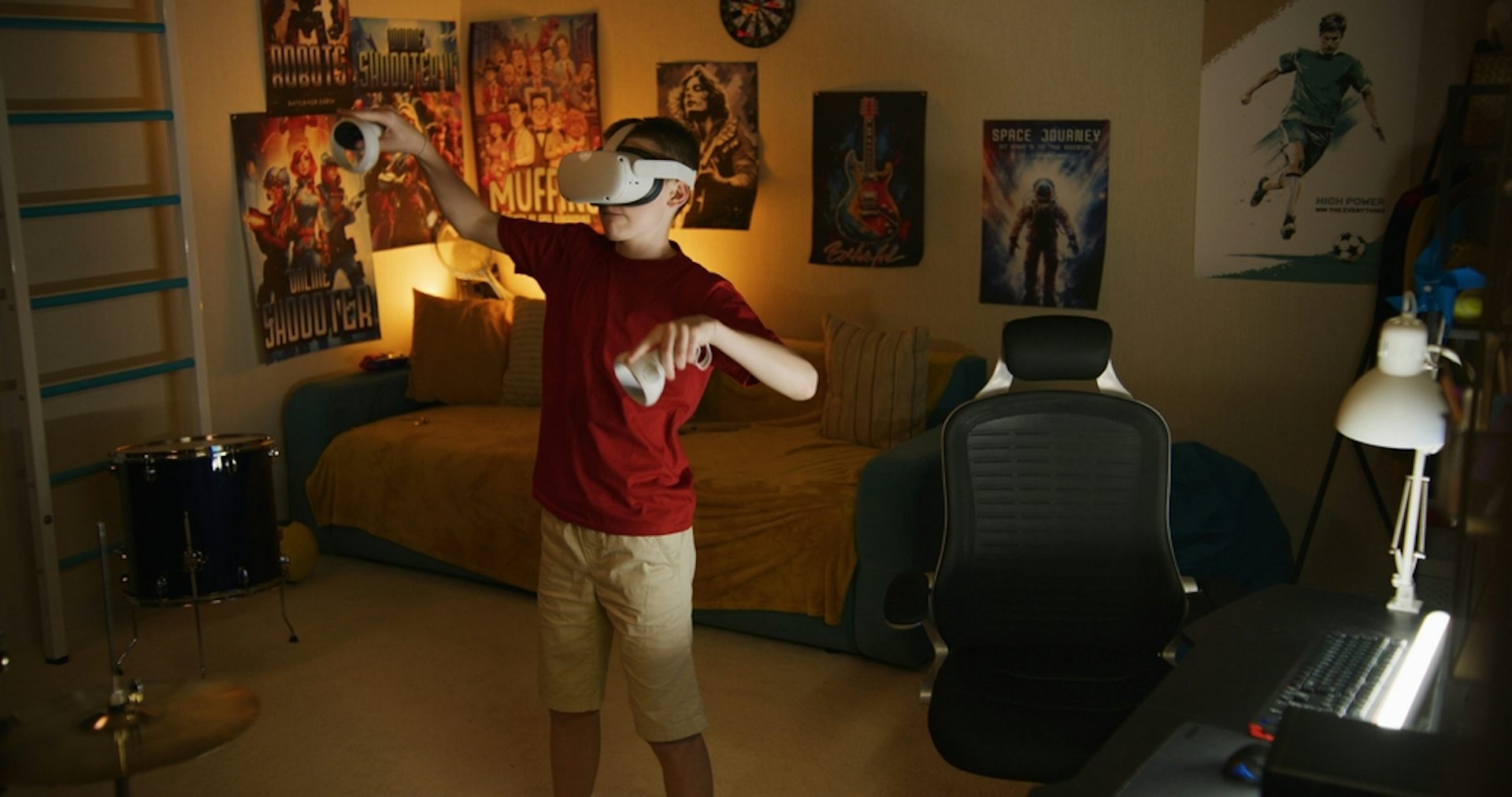
SOK Studio/Shutterstock
Virtual reality (VR) headsets are increasingly popular among adults and children. They are part of extended reality environments, which “enable ever more realistic and immersive experiences”.
VR provides entry into computer-generated 3D worlds and games with different environments and interactions. Sometimes this is loosely referred to as the “metaverse”.
The majority of VR headsets have a lower age limit of 10–13 years due to safety concerns of extended reality technologies in general and VR headsets in particular.
But VR is increasingly used by young children, even of preschool age. These immersive technologies make it difficult to monitor children’s physical and emotional experiences and with whom they interact. So what are the dangers, and what can we do to keep the kids safe?
Read more:
What is the metaverse, and what can we do there?
The good and the bad
VR allows children to dive into a digital world where they can immerse themselves into different characters (avatars). Thanks to the richness of the stimuli, VR can give the illusion of actually being in the virtual location – this is called “virtual presence”.
If children then interact with other people in the virtual world, the psychological realism is enhanced. These experiences can be fun and rewarding.
However, they can also have negative impacts. Children tend to have difficulty distinguishing between what occurs within VR and in the real world.
As children identify with their avatars, the boundary between them and the VR device is blurred when playing in the metaverse.
Children can even develop traumatic memories when playing in virtual worlds. Due to the immersive nature of VR, the sense of presence makes it feel as if the child’s avatar is actually “real”.
Research is still emerging, but it is known children can form memories from virtual experiences, which means sexual abuse that occurs virtually could turn into a real-world traumatic memory.
The rise of ‘cyber grooming’
Research has found that online predators use different grooming strategies to manipulate children into sexual interactions. This sometimes leads to offline encounters without the knowledge of parents.
Non-threatening grooming strategies that build relationships are common. Perpetrators may use friendship strategies to develop a relationship with children and to build trust. The child then views the person as a trusted friend rather than a stranger. As a result, the prevention messages about strangers learned through education programs are ineffective in protecting children.
A recent meta-analysis found that online sex offenders are usually acquaintances. Unsurprisingly, a proportion of adult predators pretend to be peers (that is, other children or teens).
Sexual approaches by adults occur more commonly on platforms that are widely used by children. “Sexual communication with a child” offences, according to police statistics from the United Kingdom, increased by 84% between 2017–18 and 2021–22.
Read more:
Children have been interacting in the metaverse for years – what parents need to know about keeping them safe
Due to the hidden nature of cyber grooming, it is difficult to know the true prevalence of this issue. Some police reports in Europe indicate that approximately 20% of children have experienced online sexual solicitation, and up to 25% of children reported sexual interaction with an adult online.
Concerning reports by Europol indicate that children have been drawn into erotic role play online. In interviews with researchers, some parents have also shared anecdotal experiences of their children being exposed to explicit sex acts on social online gaming platforms such as Roblox.
Such encounters have the potential to create memories as if the virtual experience had happened in real life.
For parents it is important to know that cyber groomers are well versed in the use of extremely popular virtual worlds. These provide predators with anonymity and easy access to children, where they can lure them into sexual engagement.

Frame Stock Footage/Shutterstock
Parents must try VR themselves
A recent report from the Internet Watch Foundation charity reports that a record number of young children have been manipulated into performing sexual acts online.
Through the metaverse, a sexual offender can be virtually brought into a child’s bedroom and engage in sexual behaviours through the child’s VR device. As VR worlds become more immersive, the danger for children only increases.
Grooming occurs where parents least expect it to happen. To mitigate this danger, parents need to be aware of online grooming patterns – such as isolating the child, developing their trust and asking them to hide a relationship.
Recognising the signs early can prevent the abuse from happening. But this can be difficult if parents aren’t familiar with the technology their child is using.
To help them understand what their children experience in extended reality environments, parents must familiarise themselves with VR and the metaverse.
If parents experience and experiment with the VR technology themselves, they can have conversations with their children about their experiences and understand with whom the child might interact with.
This will allow parents to make informed decisions and put tailored safeguarding measures in place. These safeguards include reviewing the parental controls and safety features on each platform, and actively learning what their children are playing and whom they are interacting with.
With such safeguards in place, parents can allow their children to have fun with VR headsets while keeping them protected.
If you believe your child is targeted by grooming or exploitation, or you come across exploitation material, you can report it via ThinkuKnow or contact your local police.
If you are a child, teen or young adult who needs help and support, call the Kids Helpline on 1800 55 1800.
If you are an adult who experienced abuse as a child, call the Blue Knot Helpline on 1300 657 380 or visit their website.
![]()
Marika Guggisberg does not work for, consult, own shares in or receive funding from any company or organisation that would benefit from this article, and has disclosed no relevant affiliations beyond their academic appointment.






